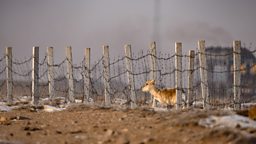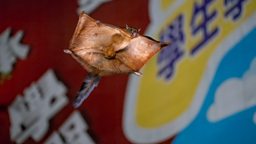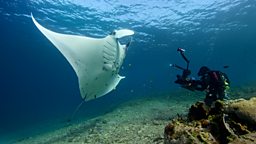Filming a family of Persian leopards whilst learning Kurdish
By Patrick Evans, Producer

At the start of production, the Tangled Worlds team set out to find a fresh story among forests less familiar to viewers, and so we began looking at the western fringe of the continent. A newspaper article led us to Kurdistan in northern Iraq, where conservation biologist Hana Raza had discovered Persian leopards inhabiting oak and pistachio woodlands high up in the mountains. We made contact, and agreed that we would work together to attempt to capture the story of this exceptionally rare big cat, hopefully marking the species’ first appearance in a major �鶹Լ�� series.
...we would work together to attempt to capture the story of this exceptionally rare big cat...
Two principle hurdles faced us. Firstly, the leopards were rarely, if ever seen. Since 2011, when Hana first recorded Persian leopards in Iraq, she had only captured a handful of camera trap images, and always of transient males, apparently passing through from neighbouring Iran, searching for females, and new territory. Despite years of fieldwork, Hana had never seen the leopards with her own eyes. It was an ominous sign for our filming ambitions.
Secondly, the place where the leopards had most recently been documented was a sensitive border zone. This location had seen fighting during the Iran-Iraq War of the 1980s, and was littered with unexploded mines. Brothers Bahez and Nabaz Faruq had grown up nearby, and knew a handful of safe paths meandering between the minefields. Through their own camera trapping and photography, they had identified several spots where we could potentially capture images of the Persian leopard, but a lot would depend on luck.

Our first trip to Iraq took place in December 2021. From the UK, Assistant Producer Ed Anderson, High Risk Advisor Lachlan Bucknall and I travelled to the city of Sulaymaniyah, and then on to the extraordinarily rugged mountains of Qara Dagh, where we spent a few days scouting and assessing camera trap locations around the places Hana had first found leopards. We received tips and hearty Kurdish hospitality from a former deputy minister of the Interior, Mamosta Jalal, who was passionate about the last remaining pockets of wilderness on his doorstep. Yet the forested mountain slopes were so colossal, and so difficult to scale, it felt that the chances of filming a leopard here were close to zero.
...we built up a glossary of useful words in Kurdish...
Beyond Qara Dagh, we travelled to the border with Iran. Accompanying us were Hana, translator and camera assistant Bnwar Abdulrahman, and several armed members of the Kurdish Asaish Security Forces, who volunteered to help protect us. They also provided us with many generous meals, including arranging a barbecue of fish on the top of the mountain, on a mist-shrouded wintry day. It was surreal, but quite delicious.
Our accommodation was somewhat less luxurious. We slept like sardines on the floor of a very modest guest bungalow, while trucks thundered by en route to and from Iran. Keen to fit in and understand the culture whilst hiking in the mountains, we built up a glossary of useful words in Kurdish, some of which were related to wildlife, and others more for everyday use. Leopard was “plng”. Its main prey, the Bezoar ibex and wild boar were “bzin” and “baraz” respectively. “Beni bash” was good morning, “shakrik klo” were little caramelised lumps of sugar, a treat to be taken with strong black Kurdish tea.

Perhaps the most-used expression however, became the word for the act of snoring, which our driver and cook Hashim was especially proficient in. Given that we all shared a room, there was ample opportunity to repeat and learn this very onomatopoeic phrase: “prch-a-prch”.
A shout went up - “plng”!
Our first trip passed, predictably, without any leopard sightings. Our second - which took place the following February - was a failure due to the heaviest snowfall in thirty years. In March 2022, I returned for the third time, already becoming anxious as to whether this gamble to film such a rare cat in such difficult circumstances would pay off.
Hana, the brothers and I hiked up into the hills to inspect a batch of cameras at a secret spot overlooking the valley, so far below us now that the noisy trucks looked like toys. Each of us headed to different cameras, unlocking them, and viewing the footage. A shout went up - “plng”! A leopard had passed in front of our cameras. Not only one video, but several, and one of them appeared to show several important details.

The footage revealed a female leopard, the first time anyone had been able to confirm filming one in Iraq, but what is more, her swollen tummy indicated she might be pregnant. For Hana, and for the whole team, this was a terrifically exciting possibility, and we captured her reactions for our behind-the-scenes film. From that day on, we all silently manifested cubs, hoping that this brief glimpse could lead to even better news.
The footage revealed a female leopard, the first time anyone had been able to confirm filming one in Iraq
As we prayed for more luck and more leopards, we left the brothers and Bnwar to maintain the camera traps, uploading new images to us each month. Finally, in September, some six months after the first record of the female, the videos for which we had all been hoping came in. Two cubs appeared alongside the mother, one female, one male. This would turn out to be the first record of Persian leopards successfully reproducing in the wild in Iraq. An expression that could sum it up might be “nanem kowta ronawa” - which roughly translates as the lucky instance when your bread falls into oil.
I travelled to Kurdistan to record Hana’s reactions as the brothers shared the footage with her for the first time. It was a remarkable moment. For many conservationists and wildlife filmmakers, seeing the animal they love to follow is part of their everyday work. But with a creature as elusive as the Persian leopard, especially when it lives in such remote and hard-to-access surroundings, even the tiniest sightings can require a lifetime’s effort.
We spent the next eighteen months continuing to monitor the camera traps, and indeed recorded several more videos both of the female, and her cubs, and of male leopards, along with lots of shots of the region’s diverse wild inhabitants. Among all the stories in the Tangled Worlds episode, this was perhaps the hardest one to pull off, but was certainly worth the effort, and the language lessons.

The Persian leopards of northern Iraq
A rare female Persian leopard and her cubs explore the mountain forests of Kurdistan.



































